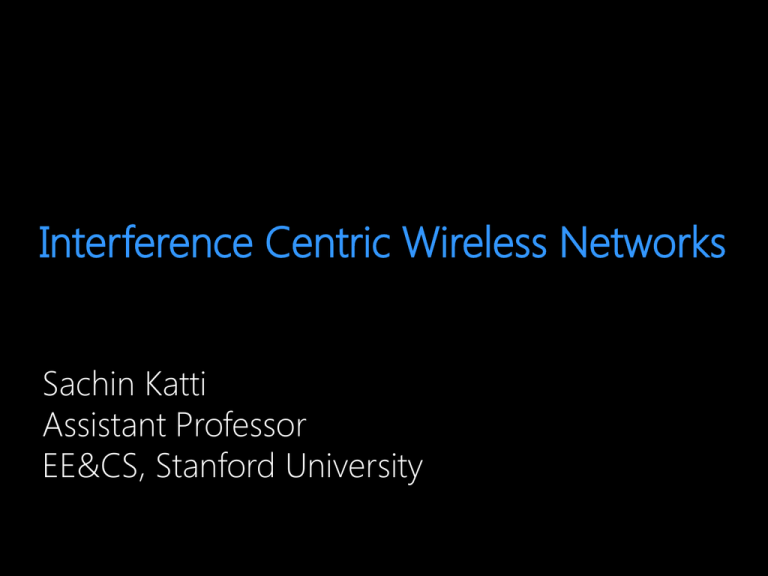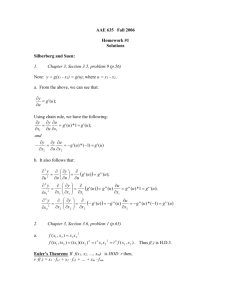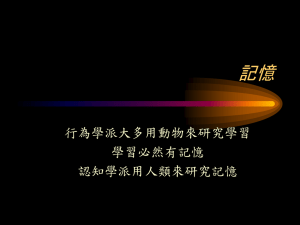pptx - Stanford University Networking Seminar
advertisement

Interference Centric Wireless Networks Sachin Katti Assistant Professor EE&CS, Stanford University Interference is Everywhere WiFi Zigbee How to maximize throughput in the Bluetooth presence of interference? Current Approach to Interference • Fears & avoids interference at all costs • Impacts all aspects of wireless design – Radios are half duplex – MAC protocols try to schedule one link at a time – Coexisting networks use different channels if possible – ……. Current Approach Cannot Scale Dense and chaotic wireless deployments Interference is unavoidable – Hidden terminals cause collisions – Coexisting networks interfere with each other – Legacy interferers (e.g. microwave) ….. Moreover, Limited spectrum + interference avoidance design Achievable capacity is fundamentally limited This Talk Fundamental rethink: Exploit interference instead of avoiding it High-Level Approach • Infer interference structure • Exploit structure to better decode interfered packets and increase throughput Exploiting Interference in All Contexts • Exploiting In-Link Interference – Full Duplex Radios (Mobicom 10,11) • Exploiting In-Network Interference – Rateless & Collision Resilient PHY (Sigcomm11) • Exploiting Cross-Network Interference – Detecting Degrees of Freedom (Sigcomm11) Exploiting In-Link Interference: Full Duplex Radios Jain et al, “Practical Real Time Full Duplex Wireless” Mobicom 2010, 2011 “It is generally not possible for radios to receive and transmit on the same frequency band because of the interference that results. Thus, bidirectional systems must separate the uplink and downlink channels into orthogonal signaling dimensions, typically using time or frequency dimensions.” - Andrea Goldsmith, “Wireless Communications,” Cambridge Press, 2005. In-Link Interference Half Duplex Radios TX RX TX RX Self-interference is millions to billions (60-90dB) stronger than received signal In-Link Interference Half Duplex Radios Analog Self Interference Analog Received Signal ADC max Digital Self Interference Digital Received Signal Tx Rx - max Self-interference drowns out received signal Our Approach 1. Infer interference structure – Easy, we know what we are transmitting! 2. Exploit knowledge of interference structure to subtract and decode First Attempt: Antenna Cancellation TX1 RX d TX2 d + λ/2 • Signal null at RX antenna • ~30dB self-interference cancellation Bringing It Together RX Antenna Cancellation Hardware Cancellation TX Signal QHX220 RF ADC Digital Cancellation TX Samples - Baseband + ∑ Clean RX samples Our Prototype Antenna Cancellation Digital Interference Cancellation Hardware Cancellation Antenna Cancellation: Performance TX1 Only TX1 Active TX2 Antenna Cancellation: Performance TX1 TX2 Only TX1 Active Only TX2 Active Antenna Cancellation: Performance TX1 TX2 Only TX1 Active Null Position Both TX1 & TX2 Active Only TX2 Active Antenna Cancellation: Performance TX1 TX2 Only TX1 Active Null Position Both TX1 & TX2 Active ~25-30dB Only TX2 Active Bandwidth Constraint A λ/2 offset is precise for one frequency TX1 RX d fc TX2 d + λ/2 Bandwidth Constraint A λ/2 offset is precise for one frequency not for the whole bandwidth TX1 RX d fc -B fc fc+B TX2 d + λ/2 Bandwidth Constraint A λ/2 offset is precise for one frequency not for the whole bandwidth TX1 RX TX2 d1 + λ-B/2 d1 TX1 RX d fc -B fc fc+B TX1 TX2 d + λ/2 RX d2 TX2 d2 + λ+B/2 Bandwidth Constraint A λ/2 offset is precise for one frequency not for the whole bandwidth TX1 RX TX2 d1 + λ-B/2 d1 TX1 RX d fc -B fc fc+B TX1 TX2 d + λ/2 RX d2 TX2 d2 + λ+B/2 WiFi (2.4G, 20MHz) => ~0.26mm precision error Bandwidth Constraint Bandwidth Constraint • • • WiFi (2.4GHz, 20MHz): Max 47dB reduction Bandwidth⬆ => Cancellation⬇ Carrier Frequency⬆ => Cancellation⬆ First prototype gives 1.84x throughput gain with two radios compared to half-duplex with a single radio. Limitation 1: Need 3 antennas Limitation 2: Bandwidth constrained (802.15.4 works) Limitation 3: Doesn’t adapt to environment Our Approach 1. Infer interference structure – Easy, we know what we are transmitting! 2. Exploit knowledge of interference structure to subtract and decode Poor Man’s Subtraction Cancellation using Phase Offset SelfInterference ∑ Cancellation Signal Cancellation using Phase Offset SelfInterference ∑ Cancellation Signal SelfInterference ∑ Cancellation Signal Frequency dependent, narrowband Cancellation using Signal Inversion SelfInterference ∑ Cancellation Signal SelfInterference ∑ Cancellation Signal Frequency and bandwidth independent Second Design: Balanced to Unbalanced Conversion +Xt/2 Xt -Xt/2 BALUN Traditional Design aT T TX Frontend R R+aT RX Frontend 1. Invert the Signal aT +T -T R R+aT 2T balun TX Frontend RX Frontend 2. Subtract Signal aT +T -T R R+aT Σ R+aT-T 2T balun TX Frontend RX Frontend 3. Match Signals aT +T -T R attenuator and delay line R+aT Σ v -vT R+aT-vT 2T balun TX Frontend RX Frontend Can Receive If v = a! aT +T -T R attenuator and delay line R+aT Σ v -vT R+aT-aT 2T balun TX Frontend RX Frontend Signal Inversion Cancellation: Wideband Evaluation • Measure wideband cancellation • Wired experiments • 240MHz chirp at 2.4GHz to measure response TX Xt +Xt/2 +Xt/2 ∑ -Xt/2 Signal Inversion Cancellation Setup RX TX Xt λ/2 Delay RF Signal Splitter ∑ +Xt/2 Phase Offset Cancellation Setup RX Higher is better Lower is better Higher is better Lower is better ~50dB cancellation at 20MHz bandwidth with balun vs ~38dB with phase offset cancellation. Significant improvement in wideband cancellation Other advantages RX TX Attenuator and Delay Line +Xt/2 ∑ -Xt/2 Xt TX Frontend • • RX Frontend From 3 antennas per node to 2 antennas Parameters adjustable with changing conditions Adaptive RF Cancellation RX TX RF Reference Attenuation & Delay Σ Balun RF Cancellation Wireless Receiver Wireless Transmitter TX Signal Path RX Signal Path • Need to match self-interference power and delay • Can’t use digital samples: saturated ADC Adaptive RF Cancellation RX TX RF Reference Attenuation & Delay Σ RSSI Balun RF Cancellation Wireless Receiver Wireless Transmitter TX Signal Path RX Signal Path • Need to match self-interference power and delay • Can’t use digital samples: saturated ADC RSSI : Received Signal Strength Indicator Adaptive RF Cancellation RX TX RF Reference Attenuation & Delay Σ Control Feedback RSSI Balun RF Cancellation Wireless Receiver Wireless Transmitter TX Signal Path RX Signal Path • Need to match self-interference power and delay • Can’t use digital samples: saturated ADC Use RSSI as an indicator of self-interference Adaptive RF Cancellation RX TX RF Reference Attenuation & Delay Σ Control Feedback RSSI Balun RF Cancellation Wireless Receiver Wireless Transmitter TX Signal Path RX Signal Path Objective: Minimize received power Control variables: Delay and Attenuation Adaptive RF Cancellation Objective: Minimize received power Control variables: Delay and Attenuation ➔ Simple gradient descent approach to optimize Bringing It All Together RX TX RF Reference Control Feedback Attenuation & Delay Σ RSSI Balun RF Cancellation Baseband ➔ RF RF ➔ Baseband DAC ADC Digital Interference Cancellation Digital Interference Reference Encoder TX Signal Path FIR filter ∆ Channel Estimate Decoder RX Signal Path Performance • • WiFi full-duplex: with reasonable antenna separation Not enough for cellular full-duplex: need 20dB more Full Duplex Implications • Breaks a fundamental assumption in wireless • Could eliminate the need for paired spectrum • Impacts higher layer design – Reduce control overhead (Radunovic et al) • Other applications – Security & Privacy (Gollakota et al) • Many more ….. Exploiting In-Network Interference Rateless & Collision-Resilient Codes Gudipati, Katti “Strider: Automatic Rate Adaptation” SIGCOMM 2011 In-Network Interference Collisions Carrier sense failure Packet collisions and loss Current Approach: Conservative backoff, RTS/CTS Our Approach: Infer Interference Structure • Current approach: – Measure channel SINR and pick modulation, coding rate – If channel SINR < decoding threshold, decoding fails – Collision SINR < decoding threshold • Key insight: Novel rateless codes for wireless • Rateless code no need to know SINR in advance, automatically achieves optimal throughput Our Approach: Infer Interference Structure • Key technique: Novel rateless codes • P1 acts as interference to P2 and vice versa Decode P1 P1 P1 P2 1. Use rateless code to decode P1 Infer interference Our Approach: Exploit Interference Structure • Key insight: Exploit rateless code to decode one packet, subtract it and decode next packet Decode P1 P1 P1 P2 _ Subtract interference __ 1. Use rateless code to decode P1 Infer interference 2. Subtract P1 from received signal and decode P2 Exploiting Cross-Network Interference Detecting Degrees of Freedom Hong, Katti “DOF: A Local Wireless Information Plane” SIGCOMM 2011 Cross-Network Interference Coexistence WiFi Zigbee How to maximize throughput in the presence of Bluetooth cross-network interference? Our Approach: Infer Interference Structure DOF infers coexisting interference structure 1. The protocol types operating in the local vicinity 2. The spectrum occupancy of each type Heart Monitor 0 ° 0 ° AoA AoA 180° WiFi AP 180° 3. The spatial directions of each type 2.3 2.3 GHz GHz Freq 2.5 GHz Smart Transmitter Smart Receiver Microwave 2.3 2.3 GHz GHz Freq 2.5 2.5 GHz GHz Key Insight “Man-made” signals hidden repeating patterns that are unique and necessary for operation CP Data CP Data CP Data ……………………. Repeating Patterns in WiFi OFDM signals Time Repeating Patterns in Zigbee signals Leverage unique patterns to infer 1) type, 2) spectral occupancy, and 3) spatial directions Our Approach: Exploit Interference Structure Exploit interference structure knowledge • Policy 0 – Only use unoccupied spectrum • Policy 1 – Use unoccupied spectrum + mw oven spectrum • Policy 2 – Use unoccupied spectrum + mw oven spectrum + compete for WiFi spectrum WiFi AoA PSD Frequency 2.3 GHz Freq 2.5 GHz Smart Rx AoA Smart Tx Heart Monitor (ZigBee Based) 2.3 GHz Microwave Freq 2.5 GHz To Conclude Future: dense, chaotic and limited spectrum Interference is the dominant determinant of future wireless network capacity • Point to point link speeds are close to Shannon Our approach: Fundamental rethink of wireless to manage and exploit interference • Increase concurrency Increase network capacity






